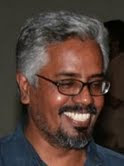BHOOMIMALAYALAM – A Budge Forward

TV Chandran talks to C S Venkiteswaran
about his filmBHOOMIMALAYALAM
All the films of TV Chandran explore and map the plight of female life in Keralam. Films like Alicinte Anveshanangal, Mangamma, Susanna, Padam Onnu Oru Vilapam, etc look at malayalee women and their lives during the last decades in Keralam. In his latest film, Bhoomimalayalam – literally, Malayalee perception of the world – Chandran weaves together the lives of several women whose lives are struggles for existence and survival, if not, expression and exuberance to excavate the world we inhabit. Bhoomimalayalam received John Abraham award for the Best film this year.
How did this film first occur to you? Was it an image, an incident, a person or a thought?
This film was actually in my mind for a long time. In a way it springs from my film ‘Kathavaseshan’ in which I wanted to use the song of a Pakistani singer. It went like this: “At night, when alone, why are women scared?” (Rath mein andhere mein, ladkiyam kyon darthi hei?). Due to copyright issues, I couldn’t use that song in that film. Instead I gave these lines to Gouhar Raza and created songs for that film. It is from this song that this film sprang, this image of the fear of women when alone. In that way, this film is a continuation of Kathavaseshan in many ways. So, when you say that my film is ‘female-oriented’ it doesn’t make sense, since there are many common elements recurring, and certain moments and characters finding their place in all my narratives..
The issues dealt with and the structure of the film is not something that I ‘thought up’ or developed through research. There are several things happening simultaneously in my mind. For instance, in the film though there are references to many real incidents, none of them are shown in the film. They do not appear as such in the film, but the film is ‘about’ those incidents. More than the incident itself, what becomes important is those who are affected by it. They stand within it and it triggers nightmares in them. Maybe that boy didn’t get drowned like this or that brother was not exactly beaten to death in front of his mother. Maybe these things happened in a different way. And that girl is actually dreaming about a suicide that never happens. The past events in Thillankeri are actually recollected by the daughter who was not even born then. So these incidents are in the background and what the film explores is the aftermath, the effects and affects.

All your films have looked at the plight of women, but Bhoomimalayalam is structurally different from the earlier attempts. Can you elaborate on that?
I think it is a transformation from one to many. In earlier films, I placed one single individual at the centre of the narrative. In this film there are several women. This film weaves together the experiences of seven different young women from different walks, times and parts of Kerala. All of them share something between them - fear – something that pervades their lives. And they all have nightmares.
What I am trying to do is to map the consciousness of a region through the lives, experience, dreams and anxieties of these women. In this narrative, the conscious and the unconscious mesh together. That was what I was trying to explore
I have also tried to map it in time and space; you have incidents and places of 1948 and then the present; likewise you can also find the narrative stretching geographically across Keralam. It is also a rumination upon our present ‘state’ – a stocktaking of sorts through time. This, I think is a shift from my earlier films.
In a way it is history, history as nightmare..
But each woman experiences, understands and faces them differently. In the film you find that one girl accepts the murder and then the death of two men in her lives, another one escapes a rape attempt, yet another one survives a divorce, while one girl is pregnant and alone, she is helpless. Finally one girl triumphs and makes a leap, out and away, from this nightmare. This is how the film is structured. And I don’t end the film on the girl who wins. Instead it ends with the other girl who is witness to it, who for me represents all the others. Maybe they all desired that triumph, like her, the winner. So again, more than the incident itself, it is the look and experience triggered by it that the film follows..
Where does this film find a place in your oeuvre?
I consider the words of Mani Kaul, who was the Jury chairman for the John Abraham Awards about the film a great recognition. He said we are nobody to judge a film. So what one can do is to see whether a film is able to move the medium of cinema a bit forward. Judgment is all about this and not comparing one with another and placing one against and above the other.
I found those words of Mani Kaul very important and inspiring. For I believe that through each and every film, what I am trying to do is to move an inch forward from where we are, to make a budge..
Labels: malayalam cinema, t v chandran


0 Comments:
Post a Comment
Subscribe to Post Comments [Atom]
<< Home